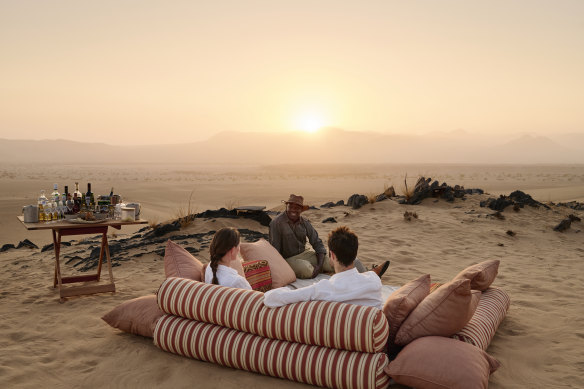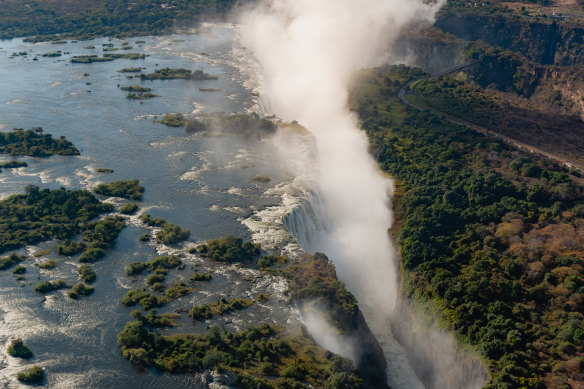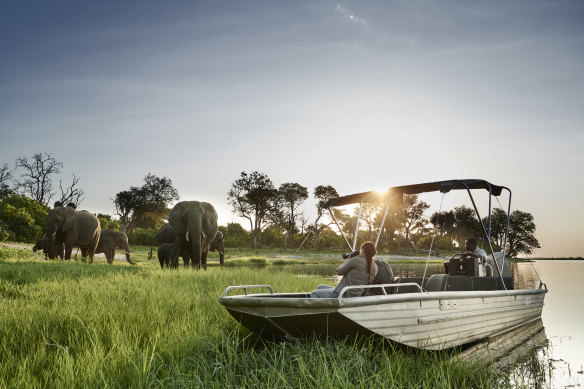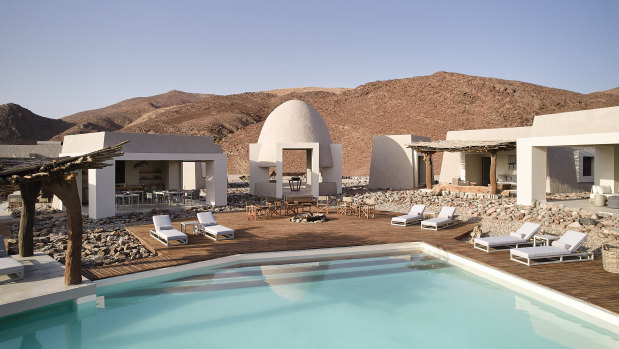10 days, three lodges, three countries and nature’s wonders
Venus glitters above the sliver of the new moon in Namibia’s night sky. The swathe of stars is so creamy it engulfs the Milky Way. I crane my head, exalted by nature’s display. The astronomical phenomenon comes as a shock. I’d anticipated semi-desert and wildlife in Namibia. But not a spectacular, glittery mass of constellations. I shouldn’t be surprised.
I’m on a 10-day Abercrombie & Kent tailor-made itinerary that incorporates three different lodges in Zambia, Botswana and Namibia. While gourmet meals, luxury accommodation and passionate guides are as consistent as the sun, each lodge in this diverse journey delivers uniquely stellar moments.

Enjoy sundowners enveloped by a soft orange glow and warm breeze.
My first stop, Sussi & Chuma Lodge, Zambia, is located on the Zambezi River near Mosi-Oa-Tunya (Victoria) Falls in Mosi-Oa-Tunya National Park. Twelve chic treehouses are connected by a raised walkway, sufficiently beyond the reach of the park’s elephants. Each morning, I cradle a tea cup and listen to Africa wake: cranky hippos grunt as their overnight feeding is interrupted by daylight. Small weavers flit in and out of their hanging nests.
After breakfast (fresh fruit and eggs benedict, enjoyed on one of several outdoor decks that cascade down to the river), we take an exhilarating boat trip. As we whip over the Zambezi’s swirling whirlpools, I envisage missionary-explorer David Livingstone in a dug-out canoe being buffeted by the eddies and peering over the lip of the 108-metre Mosi-ao-Tunya Falls (he renamed them Victoria Falls in his Queen’s honour).

Victoria Falls from the air.
Later, we head to the falls on foot. It’s May and water levels are at their highest. A thick curtain of spray obscures the falls; about 500 million litres every minute spill over the lip into the chasm below. From the skies it’s another matter, as I discover on a 30-minute helicopter flight, where clear birds’ eye vistas reveal mist creeping from the giant crevasse. It’s magical.
Safely back on ground, we’re driven through the 24-square kilometre Mosi-Oa-Tunya National Park. The park’s Mopane bushes, Russet Bushwillow and Natal mahogany provide fodder for other animals: impala, kudu and buffalo; waterbuck, zebra and giraffes.
But the park’s prizes are 10 white rhinos, the result of successful conservation efforts and park guards, including Kapoka, a rifle-wielding rhino protector and scout who has staved off park poachers for the past 29 years. We follow Kapoka on foot to observe the rhinos from a safe distance.
My next stop for two days, Chobe Chilwero Lodge, is an easy two-hour drive into Botswana. Surrounded by lush lawn that’s dotted with Zambezi teak, fig, and silver cluster trees, this handsome place sits on the doorstep of Chobe National Park, a protected area of 11,000 square kilometres.
“Chilwero” means “view point” in the local Subia language, referring to the Chobe River that glimmers beyond. Guests can enjoy the outlook from one of 15 suites or the communal verandah that doubles as an elegant indoor-outdoor dining area. Tasteful, too, is my spacious studio with muted decor and a polished concrete floor. But it’s not all relaxation.
A&K’s wildlife drives are exemplary; the park is renowned for its elephant population. Bobby, our tenacious guide, has other ideas. He’s determined to find a lion that was spotted earlier. We jump aboard the 4WD (A&K’s have padded armrests, especially for camera and binocular use) and whip around the sandy roads. Bingo! He spots her: a female lion, licking her jowls, having just demolished a kudu, whose carcass lies under a nearby bush. We move on; others are waiting their turn.
It’s time for sundowners on the Chobe River banks. Nature performs – a brilliant red line streaks across the water. We raise our G&Ts. “Pula!” Bobby says. “Cheers!” (“Pula”, Bobby explains, is also a hopeful toast meaning “let there be rain” and Botswana’s currency).
Drinks the following evening are aboard a double-decker cruiser. Juggling binoculars and cocktails, we survey a fish eagle, perched high on a bare branch, gripping a still-flapping reed cormorant. Elsewhere, an elephant plods out of the water and rubs against an African ivory tree. Hippos bob like giant brown buoys. The best is yet to come.
For my final leg, I fly via Windhoek, Namibia’s capital, to Okahirongo Elephant Lodge that’s located on the Purros Conservancy, a remote 3550-plus square kilometre desert wilderness in Kunene (formerly Kaokoland), a region of north-west Namibia. The desert below – a landscape of mountains, valleys and craters – is as alien as I’ve ever encountered. No signs of humans exist. Across the never-ending sepia-hued expanse spread veins of black contoured lines. These are plants, leeching any moisture they can find; the country is in its sixth year of drought.

On safari: wildlife converge by the river banks.
On landing, the plane shudders across the sand-and-pebble strip. We transfer to a 4WD and head to the lodge, a half-hour journey.
The dusty terrain stretches before us, flat and endless. Eventually, low hills come into view, providing a welcome spatial perspective, and we turn towards them. Three ostriches appear running jerkily, their feather “skirts” springing up and down. Elsewhere, a giraffe freezes, like a leggy supermodel posing for a photo.
We spot the line of neat, white geometric blocks on the ridge before we realise it’s our home for the next three nights: Okahirongo Elephant Lodge. Resembling an architectural model set on futuristic Mars, a series of whitewashed modules extend in a line, directly overlooking the otherworldly semi-desert. The 4WD revs over the crest and proceeds along the rim. It stops near the entrance, an egg-shaped building, a nod to a traditional hut built by the Himba people, the semi-nomadic pastoralists of the region.

The decor of Okahirongo Elephant Lodge creatively infuses elements of the wilderness surrounds.
The modules are, in fact, eight spacious suites plus a complex of communal spaces connected by decking that surrounds an infinity pool. The rooms and spaces are delightful, though there’s not much time to lounge.
Each day, we explore our surroundings, both in the 4WD and on foot, with Karitjangua, a local OmuHimba and a gentle, wise guide. At the Elephant Coast Viewpoint we watch the fog creep inland through the hills, like dry ice. We wander through the Clay Castles, a series of undulations and eroded peaks. We spot oryx, springbok and Hartmann’s mountain zebras.
Along the way, Karitjangua imparts his knowledge: an elephants’ obsession with the plant chemiflora. How ostriches arrange their eggs by size. He points out helmeted guinea fowl and hornbills. (The region’s brown hyena and 15 known desert lions, tracked by Tosco, a conservation organisation, elude us.)
One evening, he serves sundowners on a basalt outcrop of a table-top mountain overlooking the dry valley below. We’re bathed in a bright orange glow. To our delight, the region’s only bull elephant emerges through a cluster of palms and ana trees. Incredibly, the plants here eke out enough water to survive. The drought is detrimental, not least for the locals, as we learn when visiting a traditional Himba village, eight kilometres from the lodge.
The village comprises several huts surrounded by a corral; the chief is away, we’re told, though four females and two males are still living here. Zahavara, a village matriarch, explains the impact of lack of water on her community and their semi-nomadic lifestyles. Karitjangua, a son from this village it transpires, translates.
“We’ve lost our livestock (goats). It’s reduced the local people’s movement. We’re now sitting in one place,” she says.
When it comes, it comes as a shock: water. Or rather the sound of it sloshing under our tyres. The 4WD has entered a section of the Hoarusib River Valley where the bed is a mere trickle, but water nonetheless. A mass of reeds, wild tobacco and wild tamarisk trees fill the valley. Several pastoralists sit among the grasses, patiently observing their 20 or so head of cattle, their precious assets. We exchange waves.
It’s late afternoon; we exit the valley and re-enter the flat, dry desert that’s by now an umbral shade. Three giraffes (dust erupts as they flee from the approaching vehicle) provide another point of reference to the limitless depth of field.
And here I am, on my final evening, turning my head skyward. To eternity. The breadth of starry coverage is astounding.
The surrounding silence gives me space to reflect on this intergalactic journey.
THE DETAILS
Stay
A 10-day, tailor-made Abercrombie & Kent itinerary including stays at Sussi & Chuma Lodge (Zambia), Chobe Chilwero Lodge (Botswana) and Elephant Lodge (Namibia) costs from $17,680 a person. See abercrombiekent.com.au
More
The writer was a guest of Abercrombie & Kent.
Sign up for the Traveller Deals newsletter
Get exclusive travel deals delivered straight to your inbox. Sign up now.